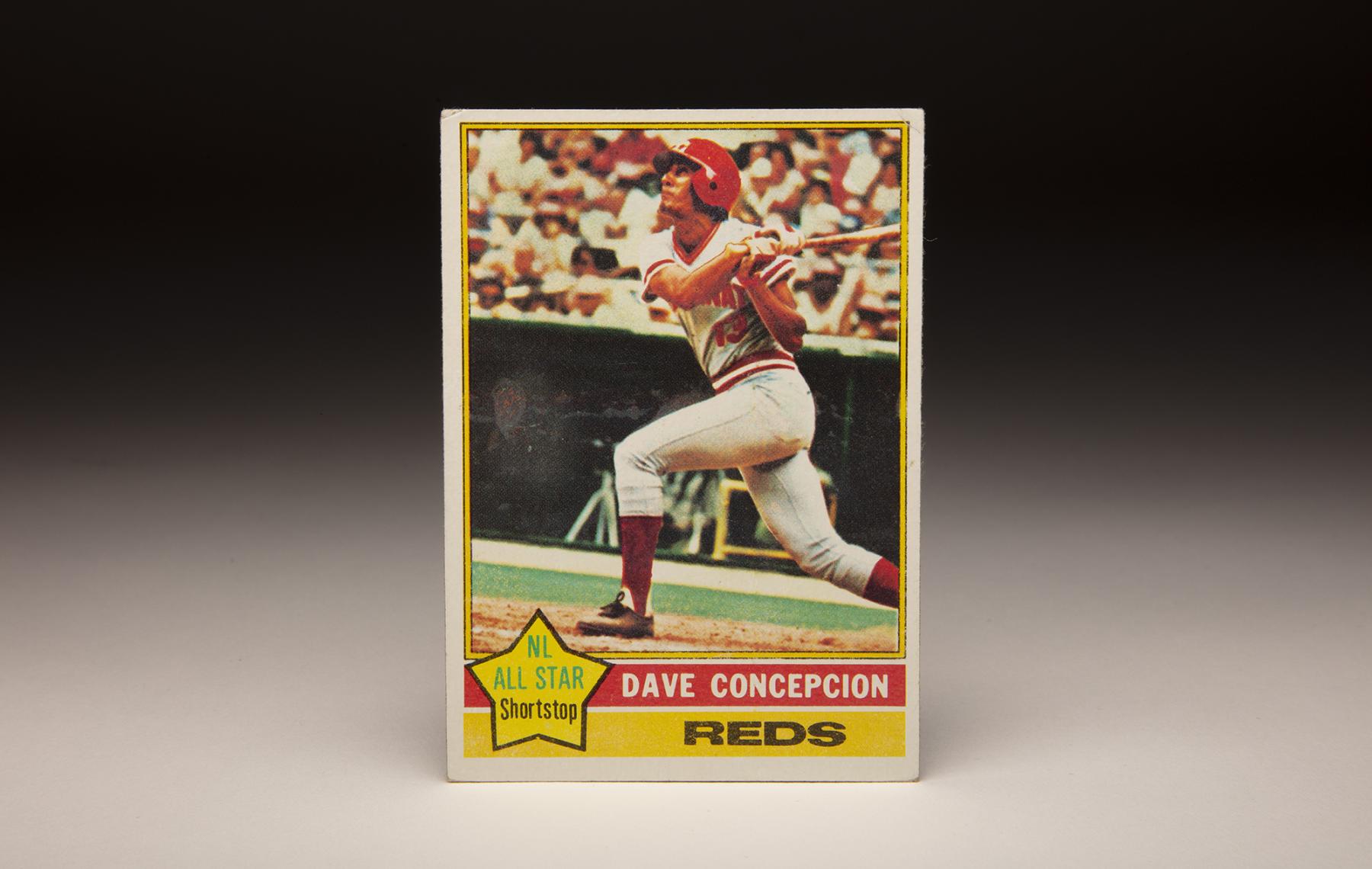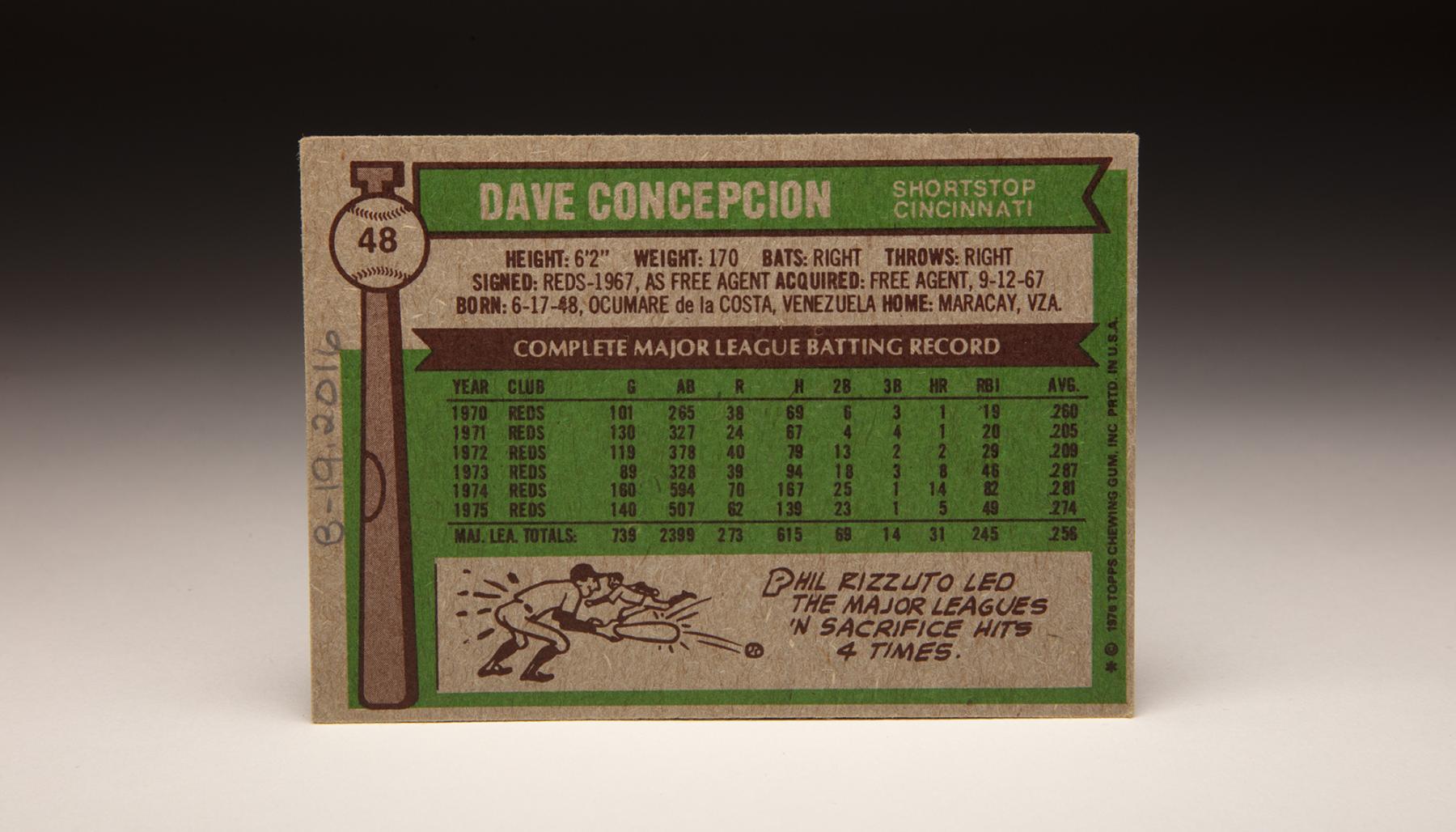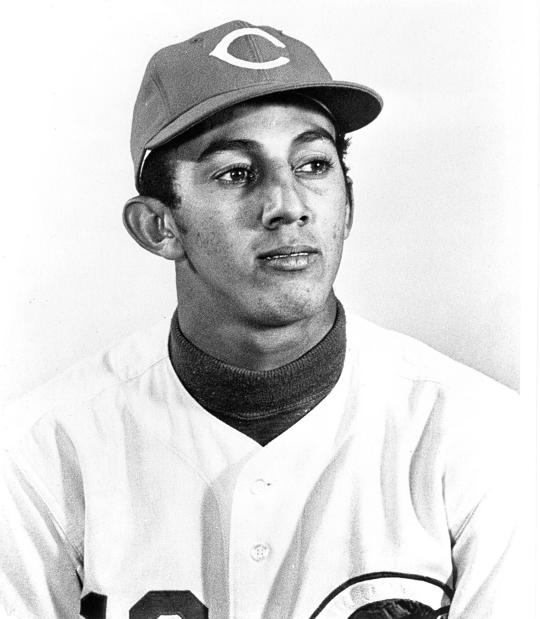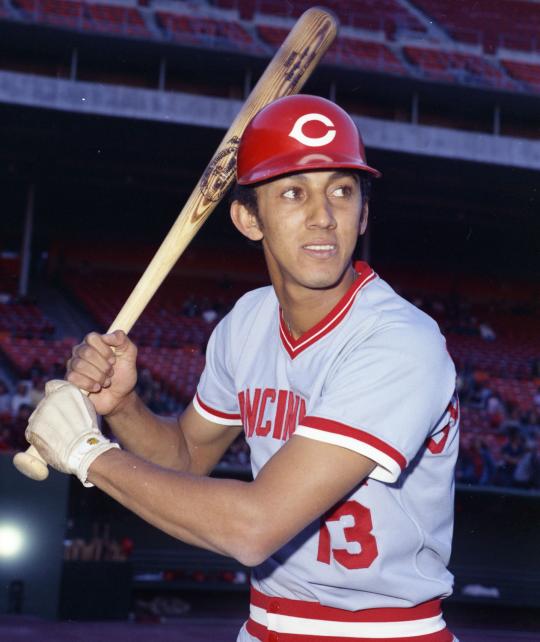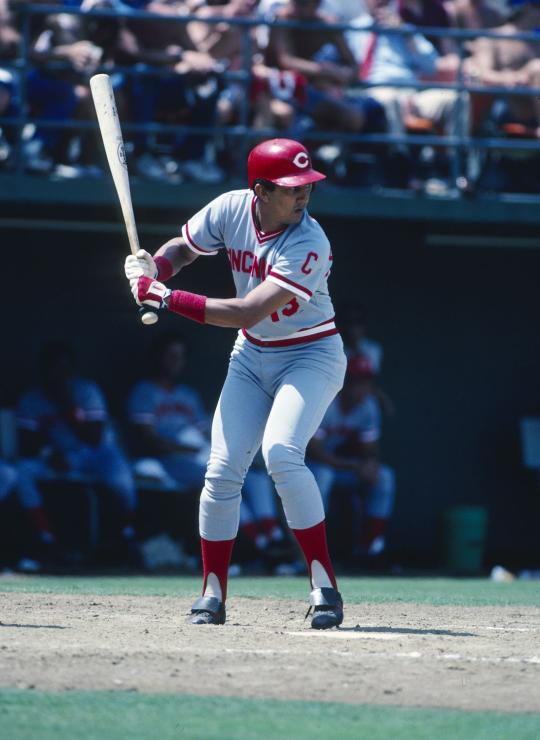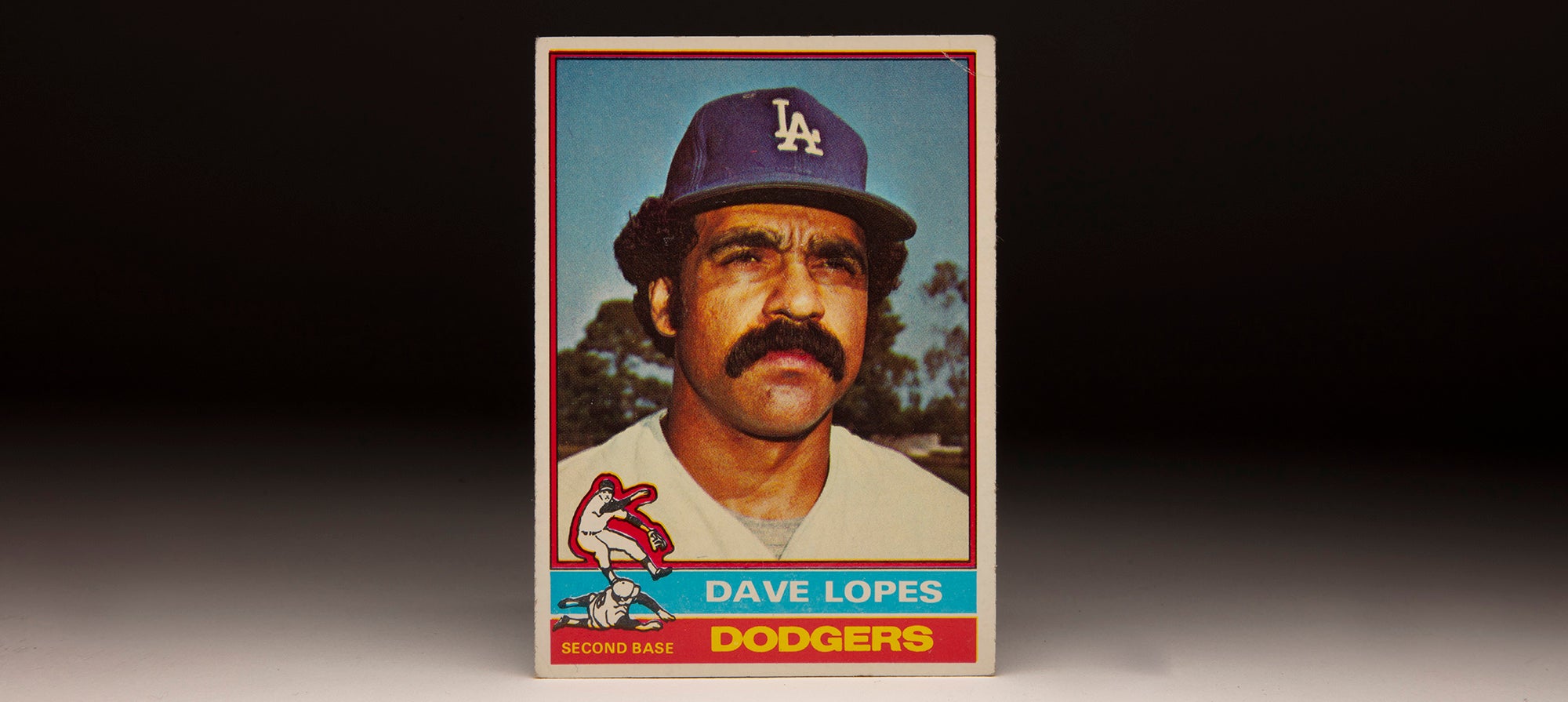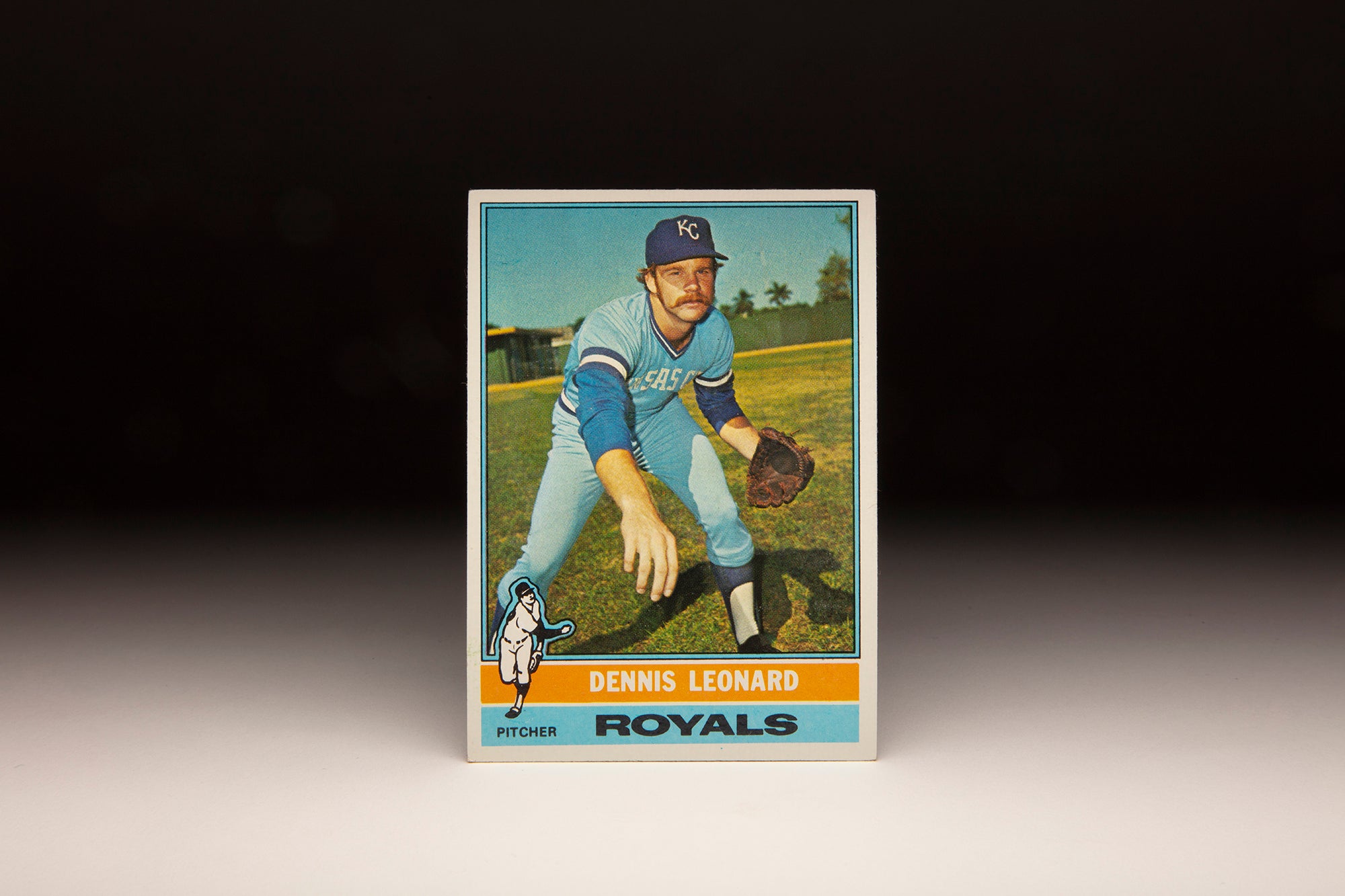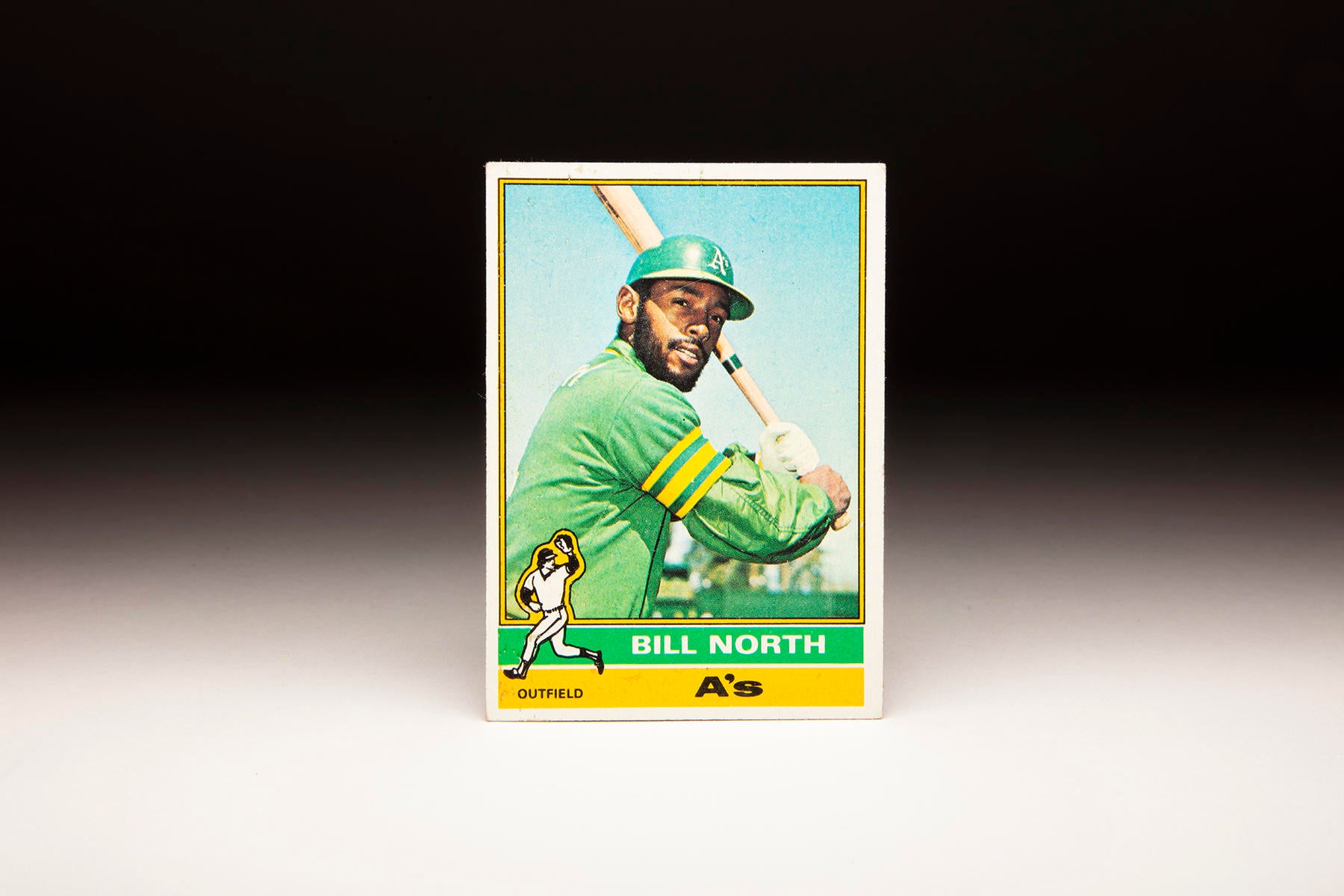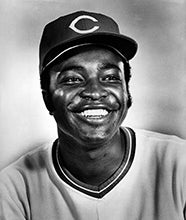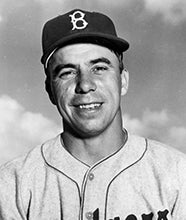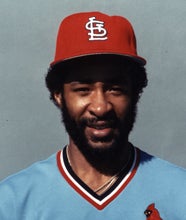- Home
- Our Stories
- #CardCorner: 1976 Topps Dave Concepción
#CardCorner: 1976 Topps Dave Concepción
On the night of Tuesday, July 13, at Montreal’s Olympic Stadium, Dave Concepción lined a 1-1 pitch from Boston’s Dennis Eckersley down the left field line and into the stands, giving the National League a 2-1 lead over the AL in the second inning of the 1982 All-Star Game.
Concepción jubilantly rounded the bases, pumping his fist before receiving congratulations from third base coach – and his Cincinnati Reds manager – John McNamara.
At that very moment, Concepción may have been the best all-around shortstop in baseball. And though the coming years would see others surpass his totals at the plate and in the field, Concepción’s 19-year big league career remains a portrait in excellence.
Born June 17, 1948, in Ocumare de la Costa, Venezuela, Concepción’s father drove a truck for a living. His son fell in love with baseball as so many Venezuelans did – through the exploits of their record-setting countryman, Luis Aparicio.
On Sept. 12, 1967, Concepción signed with the Reds as an international free agent. At the time, he was working in the loan department of a Venezuelan bank.
Official Hall of Fame Merchandise
Hall of Fame Members receive 10% off and FREE standard shipping on all Hall of Fame online store purchases.
“The scout had already signed three other guys, but his contract called for him to sign four,” Concepción told the Cincinnati Enquirer. “So, he said: ‘Concepción, you’re in. You’re a Cincinnati Red.’
“I signed. I was the only one who (made it to the majors).”
Concepción hit .234 in his first year in pro ball in 1968 with Class A Tampa of the Florida State League, quickly establishing himself as a top-shelf defender while leading the league in several fielding categories. He began the 1969 season with Double-A Asheville and hit .294 in 96 games, earning an in-season promotion to Triple-A Indianapolis.
With the Indians, Concepción hit .341 in 42 games – setting the stage for his debut in Cincinnati the following season.
After impressing Reds manager Sparky Anderson in Spring Training, Concepción was named Cincinnati’s Opening Day shortstop.
“If Concepción hits .220,” Reds pitching coach Larry Shepard told the Indianapolis Star, “he still helps the pitchers with his glove.”
The Reds used several players at shortstop in 1969, but with the arrival of Concepción, the team found a player who would anchor its infield defense during a decade of winning.
“He keeps getting better and better,” Indianapolis manager Vern Rapp told the Associated Press.
Concepción hit regularly throughout the 1970 season, peaking at .310 in May and hitting .282 as late as Sept. 18 before a late slump saw him finish at .260. Defensively, however, he made 22 errors in 93 games at shortstop, prompting Anderson to often call on veteran Woody Woodward.
Woodward started all three games at short in the Reds’ sweep of the Pirates in the NLCS but had just one hit in 10 at-bats. After Woodward went 0-for-4 in the first two games of the World Series against the Orioles, Anderson turned to Concepción – who drove in two runs with a single and a sacrifice fly in Game 3 and added another RBI in Game 4.
The Reds lost the World Series in five games, but Concepción has established that he was the shortstop of the future.
In the second game of Spring Training in 1971, however, Concepción tore ligaments in his right thumb while diving to tag White Sox runner Rich McKinney. He was outfitted with a cast and missed the first 10 games of the regular season as Woodward took over at shortstop again.
After serving in a utility role for two weeks, Concepción returned to his starting shortstop job. A summer slump never abated and Concepción finished with a .205 batting average in 130 games. But he made only 12 errors in 112 games at short.
The Reds finished fourth the NL West in 1971, prompting a team shakeup that brought Joe Morgan to Cincinnati following a trade with Houston.
Morgan and Concepción would be the Reds’ double play combination for the next eight seasons, forming an air-tight seal up the middle. In those eight seasons, Concepción and Morgan would win five Gold Gloves apiece.
Concepción struggled at the plate again in 1972, hitting .209 in 119 games. But with Morgan powering the Big Red Machine offensively, Cincinnati reclaimed the NL West and again beat Pittsburgh in the NLCS. This time, Anderson started Darrel Chaney in all five games against Pittsburgh, with Concepción coming to the plate only two times in three games as Anderson platooned the two – with the switch-hitting Chaney drawing starts against the Pirates’ bevy of right-handed hurlers.
But in the World Series, the American League champion Athletics featured lefty starters Ken Holtzman and Vida Blue. Concepción drew starts in four of the seven games, hitting .308 while appearing in six of the seven contests. The A’s, however, won a series that featured six one-run games.
“For some reason, I play better in championship games,” Concepción told the Courier-Journal in Louisville, Ky.
Concepción’s stellar play in the World Series carried over into the 1973 season. A hot start saw him hitting .356 at the end of April, and he was hitting .287 with 46 RBI and 22 steals in the seventh inning of a July 22 game against the Expos when he went from first to third on a groundout by teammate Denis Menke. Upon sliding into the bag, Concepción’s left leg caught on the base – fracturing his foot and his shin.
“Put me to sleep… put me to sleep,” Reds third base coach Alex Grammas remembered Concepción saying as he asked for a pain-killing shot.
The All-Star Game would be played three days later, but Concepción – already named to the team – would miss it as he was sidelined for the rest of the year.
The fractures, however, healed – and Concepción continued his outstanding play in 1974. Appearing in 160 games, he batted .281 with 14 homers, 82 RBI and 41 steals while winning his first Gold Glove Award and finishing 15th in the NL Most Valuable Player voting.
In 1975, the Reds fulfilled their championship pedigree – and Concepción was one of the regulars who would one day be referred to as the “Great Eight”. He batted .274 with 33 steals, earning his second All-Star Game selection and winning his second Gold Glove Award.
In the NLCS against the Pirates, Concepción batted .455 in the three-game sweep, going 3-for-4 with two steals in Game 2. He hit safely in five of the seven games of the World Series against the Red Sox, totaling four RBI and three steals.
In Game 2, his two-out, ninth-inning single scored Johnny Bench to tie the game at 2, and he later scored on Ken Griffey Sr.’s double to give the Reds a 3-2 win and tie the series at one game apiece.
It would be a pivotal moment in a World Series that would be rated as one of the best of all-time.
The next season, the Reds were even better – as was Concepción. Cincinnati rolled to 102 regular season wins before sweeping the Phillies in the NLCS and the Yankees in the World Series, with Concepción batting .357 with three RBI in the Fall Classic.
He was named the NL All-Star Game starter at shortstop for the second straight year – an honor he would receive a total of five times – while batting .281 with 69 RBI and winning his third straight Gold Glove Award.
In March of 1977, Concepción and the Reds agreed to a new five-year contract worth $1 million.
“He’s a very valuable player, and his position is a tough job to fill,” Reds executive Dick Wagner told the Associated Press. “By age, he should be coming into his own.”
At 28 years old entering the 1977 season, Concepción was at his peak.
He hit .271 with 64 RBI and 29 steals that year while yet again earning All-Star Game honors and a Gold Glove Award, then followed up by hitting .301 in 1978 with 67 RBI and 23 steals. His string of four straight Gold Gloves was snapped by Larry Bowa, but Concepción was widely regarded as the game’s most complete shortstop.
“Davey is the best shortstop in baseball,” said Reds manager John McNamara, who took over the team after Cincinnati finished in second place for the second straight season in 1978. “Look around and there isn’t a shortstop that fields as well as Davey and can, at the same time, hit .300 and drive in as many runs. You really appreciate Davey when you see him day-in and day-out.”
The Reds recaptured the NL West title in 1979, and Concepción set career-highs in runs scored (91), home runs (16) and RBI (84) en route to a ninth-place finish in the NL MVP voting. Cincinnati was swept by Pittsburgh in the NLCS, but the Reds appeared to be rebuilding on the fly as veterans were replaced by up-and-coming prospects.
Concepción, meanwhile, was the bridge between the generations.
In 1980, Concepción battled pain in his throwing arm but still appeared in 156 games, batting .260 with 77 RBI. He also worked on perfecting his “skip throw” to first base – intentionally firing the ball off artificial surface fields to take advantage of the true hop and lessen the strain on his arm. With half his games at Riverfront Stadium and road contests at places like Pittsburgh, Philadelphia, Houston and St. Louis that featured turf, Concepción helped invent a new defensive strategy.
“You save your arm, and the ball gets to first quicker if it’s on one good hop,” Concepción told the Associated Press. “If you throw the ball in the air and don’t have much on it, it’s going to die before it gets there.”
Concepción had elbow surgery performed by Dr. Frank Jobe following the 1980 season to remove calcium deposits and reposition a nerve, giving him back some arm strength. In 1981, he led the Reds to the best record in baseball while hitting .306 with 67 RBI in 101 games, finishing fourth in the NL MVP race and winning a Silver Slugger Award.
But Cincinnati failed to win either the division title in the first or second half of that strike-shortened season, shutting the Reds out of the playoffs. Concepción’s defense continued to be strong, but his Gold Glove Award in 1979 would be the last of his career as Ozzie Smith won the first of 13 straight in 1980.
Smith’s wizardry would cost Concepción what could have been several additional Gold Glove Awards.
But at age 32, the Reds still considered Concepción to be a franchise cornerstone. So when his contract expired following the 1981 season, the Reds quickly re-signed him to a five-year deal worth a reported $4.5 million.
The 1982 All-Star Game was a highlight for Concepción in a lost season for the Reds where Cincinnati dropped 101 games. Concepción hit .287 with 53 RBI and was named to his ninth-and-final Midsummer Classic roster, earning his second straight Silver Slugger Award. He remained the Reds’ starting shortstop in 1983 – a season in which he was named the Reds’ captain – and for much of the 1984 season, though he did play third base for about two months of the latter season. His batting average fell off in those two years (hitting .233 and .245, respectively), but he reclaimed the starting shortstop job in 1985 – appearing in 151 games at short during his age-37 season while hitting .252.
But Concepción spent almost six weeks on the disabled list in 1986 with a fractured left ring finger, opening the door for future Hall of Famer Barry Larkin at shortstop. With Concepción’s contract expiring at the end of 1986, the Reds brought him back on a one-year deal for 1987 as Larkin took over the starting job. In 104 games off the bench, Concepción batted .319.
“I just knew I couldn’t play shortstop anymore,” Concepción told the Associated Press in Spring Training of 1987. “It took a lot out of me last year.”
The Reds re-signed Concepción 1988, but he was unable to duplicate his success of 1987. On June 11, Concepción was called out on strikes by umpire Mark Hirschbeck in a game against the Giants.
En route to his position at second base in between innings, Concepción uprooted the first base bag and flung it, drawing a suspension from NL president Bart Giamatti.
He finished the season batting .198 over 84 games, then was released by the Reds immediately following the season. Concepción vowed to keep playing – he publicly criticized Reds manager Pete Rose for the way the parting occurred – but found no offers for the 1989 season.
“He’s one of the best I’ve ever seen,” Hall of Famer Pee Wee Reese told the Lexington (Ky.) Herald-Leader in 1989. “I thought he was a super shortstop.”
Following his career, Concepción maintained two farms in Venezuela and also ran a trucking business with his sons. The Reds officially retired his No. 13 on Aug. 25, 2007.
Concepción finished his 19-year career with a .267 batting average, 2,326 hits, 321 stolen bases and 950 RBI. He led NL shortstops in assists twice (1974 and 1976) and fielding percentage once (1977) and ranks ninth all-time with 2,178 games played at short. He was named to nine All-Star Games and earned five Gold Glove Awards.
“Davey Concepción was the best shortstop I ever played with,” Joe Morgan said in 2007, “and the best shortstop I ever saw.”
Craig Muder is the director of communications for the National Baseball Hall of Fame and Museum

